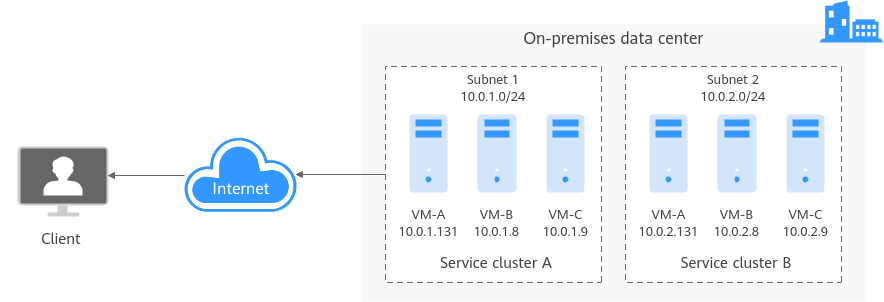Overview
Application Scenario
A company wants to migrate some workloads from its on-premises data center to the cloud. The servers in the data center are deployed in the cluster mode. Figure 1 shows the networking diagram.
During the migration to the cloud, the company has the following requirements:
- Workloads are migrated to the cloud by server and cannot be interrupted during the migration.
- The configuration files of the servers in the on-premises data center record domain names instead of actual IP addresses. Therefore, the IP addresses of servers cannot be changed after migration.
Architecture
Enterprise switches allow cloud and on-premises networks to communicate at Layer 2. Servers can be migrated to the cloud one by one without interrupting workloads or changing IP addresses.
In Figure 2, VM-B in the on-premises data center is migrated to the cloud without IP address change using an enterprise switch. The migration process is as follows:
- Use Direct Connect or VPN to allow the cloud and the on-premises tunnel subnets to communicate at Layer 3. The Layer 2 network used by an enterprise switch is based on the Layer 3 network between tunnel subnets.
- Create an enterprise switch, establish Layer 2 connections, and configure the VXLAN switch to allow the cloud and the on-premises data center to communicate at Layer 2.
- Migrate VM-B (10.0.1.8) to ECS-B (10.0.1.21), ensure that the VM-B and ECS-B can communicate with each other, and stop VM-B in the data center during off-peak hours.
When VM-B is stopped for a short time, workloads are carried by VM-A (10.0.1.131) in the data center and are not interrupted.

To verify the communication between VM-B and ECS-B, the IP address of ECS-B must be different from that of VM-B. Otherwise, the communication fails.
- Change the IP address of ECS-B on the cloud from 10.0.1.21 to 10.0.1.8 after VM-B in the data center is stopped. In this case, traffic is forwarded to ECS-B on the cloud through the enterprise switch and the IP address is not changed after the migration.
In addition, ECS-B on the cloud and VM-A in the data center can communicate with each other as if they were in the same subnet.
Advantages
- On-premises workloads communicate with each other using IP addresses instead of domain names. Reconstructing the on-premises network before cloud migration prolongs the cloud migration period, interrupts businesses, and increases O&M costs.
With enterprise switches, the on-premises IP addresses can remain unchanged, mitigating impacts on workloads and accelerating the cloud migration progress.
- Dozens of different workloads are deployed on each subnet of the on-premises data center. If workloads are migrated by subnet, business continuity cannot be ensured.
With enterprise switches, workloads can be seamlessly migrated to the cloud to prevent any loss caused by cloud migration.
Notes and Constraints
- If you want to use a VPN connection together with an enterprise switch, submit a service ticket to check whether your connection supports VXLAN interconnection with an enterprise switch. If your connection does not support this, contact customer service.
- If you want to use a Direct Connect connection together with an enterprise switch, submit a service ticket to check whether your connection can interconnect with an enterprise switch. If your connection does not support this, contact customer service.
- If you use an enterprise switch to connect your on-premises data center to the cloud, the switches of your data center must support the VXLAN function. The following lists some switches that support the VXLAN function.
- Huawei switches: Huawei CE58, CE68, CE78, and CE88 series switches, such as CE6870, CE6875, CE6881, CE6863, and CE12800 switches
- Switches of other vendors: Cisco Nexus 9300, Ruijie RG-S6250, and H3C S6520 series switches
Feedback
Was this page helpful?
Provide feedbackThank you very much for your feedback. We will continue working to improve the documentation.See the reply and handling status in My Cloud VOC.
For any further questions, feel free to contact us through the chatbot.
Chatbot







